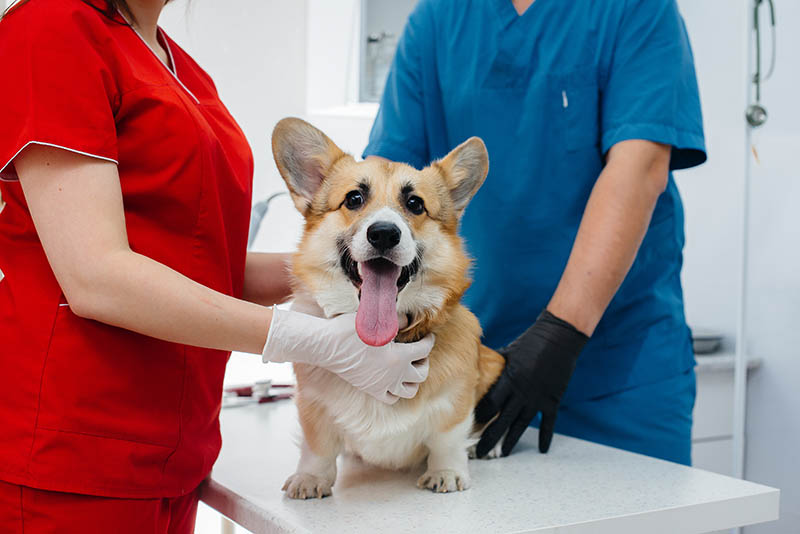Male vs Female Weimaraner: Main Differences (With Pictures)
Updated on

Click to Skip Ahead
Affectionately known as the silver ghost, the Weimaraner is beautiful to look at and a joy to own. Both sexes are loyal and rewarding pets.
At first glance, it is immediately evident that the female Weim is noticeably smaller than her male counterpart. She is more introverted compared to his boisterous joviality.
These differences and the others that we will have a look at in this article will hopefully help you decide whether a girl or a boy Weim will be coming home with you soon. Who knows, maybe one of each!
Visual Differences

At a Glance
- Average height (adult): 25–27 inches
- Average weight (adult): 70–90 pounds
- Average height (adult): 23–25 inches
- Average weight (adult): 55–75 pounds
Weimaraner 101
The Weimaraner was originally bred in the 19th century by German nobles for big game hunting. Those strongly honed hunting instincts persist in the breed today and that’s why Weims are not suited to multi-species households. With correct and early socialization, they will get on just fine with your other dogs, but given half a chance they will hunt and kill other pets such as cats, rabbits, reptiles and birds.
They love humans of all ages and are terrific with kids—they just love to be involved with every aspect of family life. Because of their athletic and energetic dispositions, they make wonderful canine companions for active families that enjoy the outdoors. Their alertness and loyalty make them great watchdogs. The Weim is an exceptionally intelligent and active hound that is eager to please, happy and generally obedient.
Male Pet Breed Overview

Personality / Character
The male Weim just loves to play and have endless fun! Their play tends to be on the boisterous side and they can be unaware of their size and strength.
Although officially an adult between the ages of one and two years, he can take much longer than this to properly mature. This immaturity is evident when it comes to his emotions and pain tolerance. He will let you know when he is unhappy, sometimes destructively. A thorn in the paw or bump to the nose could take on apocalyptic proportions.
Males are affectionate, loyal, and eager to please. They are devoted to their human/s and would be lap dogs if their size didn’t prevent it.
Training
The male Weim’s great intelligence and eagerness to please make him easy to work with and train. He loves the simple pleasure of obliging his human, although he is easily distracted.
Because of his working dog roots, training and regular exercise need to be included in his care regime. He requires mental and physical stimulation to keep him emotionally stable. Weimaraners excel in competitive obedience and agility classes.

Health & Care
As mentioned above, it is vital to include fairly rigorous exercise in a male Weim’s care regime. They were bred to be active in the field for up to six hours a day and that stamina prevails in the modern breed.
Because of their energetic exuberance, they are prone to bumps, strains, and scrapes. Usually, these injuries will not be severe and they will recover quickly with first aid home treatment. If you are ever concerned about an injury, you should seek veterinary advice immediately.
They are a robust and healthy breed of dog, in general, but as with most purebred dogs, Weimaraners are prone to several genetically inherited conditions. Males are predisposed to dilated cardiomyopathy (DCM), an enlarged heart that does not function properly, and steroid-responsive meningitis-arteritis, an inflammation of the spinal and brain membranes and artery walls.
Additionally, both male and female Weimaraners are predisposed to gastric torsion, entropion, hypothyroidism, progressive retinal atrophy, hip dysplasia and a bleeding disorder called Von Willebrand’s disease.
Breeding
Unless you plan to breed with your male Weim it is advisable to have him neutered. Intact males might become aggressively territorial and tend to roam and urinate on more objects, more frequently. Neutering also reduces the risks of prostrate problems and eliminates testicular cancer.
Neutering should be carried out around the one-year mark, once your boy is mature. Doing so earlier may predispose him to certain health issues. Note that your neutered boy may take a little longer to mature.
- Easy to train and housebreak
- Easygoing and eager to please
- Very boisterous and playful
- Might not calm down with age
Female Pet Breed Overview

Personality / Character
The female Weim is a calmer and generally more sensible lass that matures faster than the male. She is independent and self-sufficient, but still just as devoted to her humans as her male counterpart, just not in a “clingy” way. She may even form a stronger bond with them. Her independence can sometimes border on obstinance.
She is the more dominant of the two sexes and therefore can become very territorial. This can manifest in increased vigilance and barking at things.
Female Weims are tough! They are renowned for not being bothered by bad weather or being emotionally sensitive in the way that the males are.
Training
Madame Weim has a reputation for being a bit stubborn. This can translate into occasional rough patches during training. She may take longer to housebreak, not because she doesn’t understand but rather because she is trying to assert her will.
She still possesses the same qualities of intelligence and loyalty as the male and she is just as likely to excel in obedience and agility competitions. The same as the male Weim, she enjoys engagement and work, as long as she’s in the mood for it.
Females Weims require just as much mental and physical stimulation as males, but they are less likely to explode at the seams if they don’t get it. They may, however, still assert their frustrations destructively, albeit insidiously.

Health & Care
The female Weim requires just as much high-quality exercise as the male does to keep her in tip-top physical, mental and emotional health. She’s not as gormlessly boisterous as the male so she’s less likely to suffer from bumps and bruises as much as he might be.
Apart from the genetic disorders mentioned above to which both male and female Weimaraners are predisposed, female Weims are additionally susceptible to patent ductus arteriosus, a congenital heart defect present at birth.
Breeding
As with the male, if you are not planning to breed with your lady then it is advisable to have her spayed. This could temper any territorial aggression that may have developed and will help with moodiness making her easier to train.
Spaying prevents the Weim bitch from having “seasons” and eliminates any chance of her getting uterine infections or ovarian cancer.
- Calmer than the male
- More independent and self-sufficient
- Can be stubborn
- Can be moody (as with most female dogs)
Which Gender Is Right For You?
The female Weim may make a better guard dog due to her alert and loyal nature. She might also be the better choice if you have very small children in the house. Her calmer temperament means that little tots unsteady on their feet are less likely to be bowled over by her.
Both males and females require lots of exercise and stimulation. If you have a particularly active household with bigger kids then a male Weim could be the perfect fit.
Either way, you can’t go wrong with these loving, devoted and intelligent hounds.
Featured Image Credit: (L) Dmitry Veryovkin, Shutterstock | (R) Leoniek van der Vliet, Shutterstock













